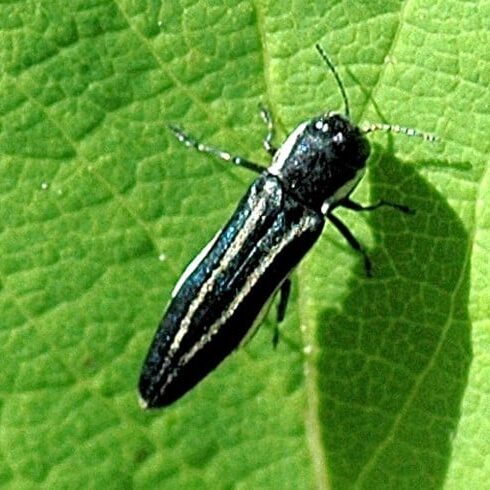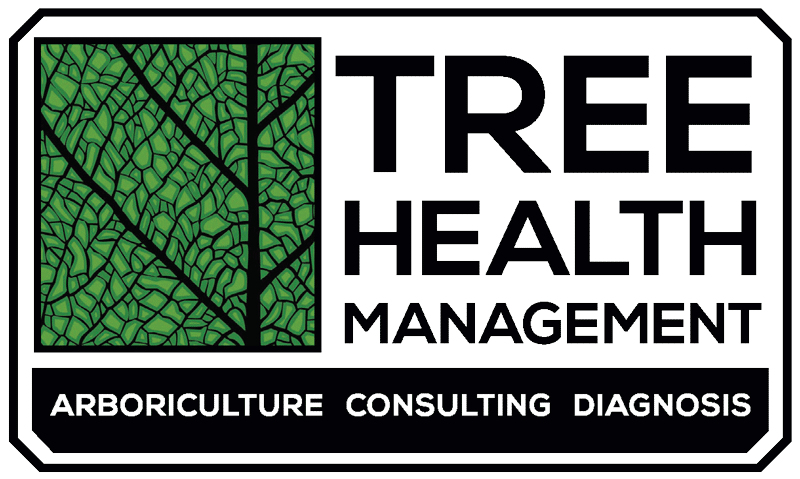Blog | Pest Management
Two-lined Chestnut Borer

Agrilus bilineatus
The two-lined chestnut borer is named for being the primary pest of the American Chestnut tree, which once dominated American forests. A blight introduced from Asia in the early 20th century decimated the American Chestnut population, and the two-lined chestnut borer turned its attention to new hosts. Today, Oak trees suffer most from the borer beetles, but they can also attack Beech and Hornbeam trees. While Bur Oaks seem to be their favorite host, two-lined chestnut borers also attack Red Oak, White Oak, Black Oak, Northern Pin Oak, and more. In the environment, they primarily attack Oaks that are already weakened or in decline. In urban environments, there are more stressors that was weaken Oaks, leaving them more susceptible to infestation. Common factors that increase the odds of attack are trunk and root injury, soil compaction, road salt injury, changes in grade due to construction, and drought. Other insect species can defoliate Oak trees, such as spongy moth and the forest tent caterpillar. Trees can survive defoliation, but it leaves them more susceptible to borer infestation.
There are a few signs of infestation to look out for. In late summer, you may see leaves of certain branches wilting and prematurely turning brown. The brown leaves will then hold on for several weeks. Those branches are dead and will not leaf out again the following year. They typically begin by attacking the upper crown and moving down into other parts of the tree.
If you remove the bark of dead branches, you will see the remaining galleries created by the borer larvae, which look like small ruts in random patterns in the wood. Oaks infected with the Oak wilt fungus can display similar symptoms, so call your arborist for a consultation if you suspect two-lined chestnut borer.
Two-lined chestnut borers are small beetles native to the southern Canada and the eastern United States. Adults have elongated bodies between 1/5 and 1/2 inch long. They are a green-to-black metallic color with two pale yellow striped down the length of their backs. The larvae are white and legless with a flattened section behind their heads. Two-lined chestnut borer typically completes its lifecycle and produces one generation in a year. Adults lay eggs in the cracks and crevices of the bark in late Spring and early Summer. The eggs hatch in about 1-2 weeks and the larvae burrow down through the bark, into the cambium layer of the tree. The larvae then feed on the xylem, phloem, and cambium of the wood, which make up the tree’s vascular systems. This feeding leaves trails carved out under the bark and cuts off the flow of water and nutrients, killing branches, roots, and eventually the whole tree. The larvae then create cavities under the bark in which they overwinter. In late spring, the adults emerge out of holes in the bark that distinctly look like “D”s. In the northern lake states, this typically begins in late May or early June, peaking in the second half of June.
The best management plan against two-lined chestnut borer is prevention. Anything that reduces the stress on Oaks lowers the odds of borer attacks. Properly mulching Oaks, avoiding fertilizers used on turf grass, preventing soil compaction, and watering during drought are great ways to take care of your Oak trees. Thinning stands of Oaks to increase vigor can help prevent infestations. Trees that are of high value or that are defoliated by caterpillars may benefit from preventative insecticide treatments. Treatments are precisely timed to target the borer beetles ate specific stages of its life. Approved insecticide treatments must be applied by a licensed professional, so talk to your arborist if you are concerned about two-lined chestnut borer. Typically, once damage is visible, it is too late to save infested portions of the tree. Some trees can even be killed in as little as one season. Properly timed pruning and treatment of removed wood can prevent the spread of infestation. The larvae are sensitive to wood drying out, so pruning and burning, chipping, or solarization of infected wood can kill the borers. Two-lined chestnut borers also have a few natural enemies, including woodpeckers and parasitic wasps.
There is no treatment program that can fully protect a tree, so make sure to take proper steps to prevent tree stress in the first place.
